Poudre de Riz
Exactly when rice powder (‘poudre de riz’) came to be used as a cosmetic in Europe has yet to be determined. Once established it was used as a base for perfume, as a powder or wash to lighten the skin, or as a powder to whiten wigs.
Take a pound of levigated Hartshorn, two pounds of Rice Powder, half a pound of Ceruss, Powder of dried Bones, Frankincense, Gum Mastic, and Gum Arabic, of each two ounces. Dissolve the whole in a sufficient quantity of Rose-water, and wash the face with this fluid.
(Buc’hoz, 1779, p. 5)
Well before it was available in the West, pulverised rice starch was used as a cosmetic in China, Japan and elsewhere in the East. The powder was probably produced in a manner similar to this method observed in the Dutch East Indies.
The women there … make their own poudre de riz by soaking the shelled rice for a day or two in cold water. The swelled up and slightly fermented kernels are then partially dried and rolled by means of a stone rolling pin, or ground up in a mortar to form a paste. This paste is further dried in the sun into cakes. For use, these cakes are rubbed fine and applied as a dried impalpable powder or made into a paste again with water and daubed on to the face.
(Phillips, 1934, p. 24)
Qualities of rice starch
Although it was more expensive, pulverised rice starch had a number of cosmetic advantages when compared to other starch powders. Rice starch particles are very small – generally in the range of 3-8 microns (Harry, 1982, p. 290) which means that rice powder feels smoother on the skin and is less opaque than other starch powders.
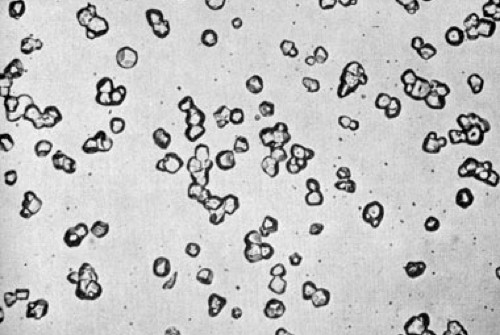
Above: Rice starch particles (deNavarre, 1941, p. 337)
When you combine this with its excellent absorptive properties and the ability of rice powder to give skin a peach-like ‘bloom’ there were few other powder bases that could match it. In addition, like other natural starches, rice powder was free of the health concerns associated – in the literature of the time – with inorganic compounds such as arsenic, bismuth, borax, lead, mercury and zinc.
Defining ‘poudre de riz’
Given the qualities of rice powder, and that it was more expensive than other starches, using the term ‘poudre de riz’ on a powder box gave the product a certain cachet. Unfortunately, there were no legal requirements for what a product labelled as such should contain, or what percentage of rice powder should be used. Poucher (1932) for example, opts for first and second grades of ‘poudre de riz’.
Poudre de Riz of finest quality invariably contains over 50 per cent of rice starch, which should be put through a 120-mesh silk at least before being added to other ingredients. This is necessary as rice starch is apt to contain rather large coagulations of starch grains, and the fine sifting eliminates them. Maize starch is used in both first and second-grade products, as little as 10 per cent in the former and as much as 90 per cent in the latter. The grains are similar in shape, but about three times the size of those from rice. Some talcum is generally added to give the necessary ‘slip.’ Here are some formulae:—
No. 1679
600 Rice starch. 200 Maize starch. 100 Talcum. 50 Magnesium stearate. 50 Zinc oxide. 1000 No. 1680
500 Rice starch. 250 Magnesium carbonate–light. 100 Osmo-kaolin. 100 Talc. 50 Magnesium stearate. 1000 (Poucher, 1932, pp. 553-554)
Labelling was an ongoing problem that would persist until ingredient listing was enforced. It is not surprising that a number of early commercial face powders that labelled themselves as ‘poudre de riz’ contained little or no rice starch. In 1897, a report on face powders by William Murrell noted that “face powders commonly employed for the complexion no longer consisted of powdered rice, but were combinations in various proportions of chalk, white lead, bismuth, common starch, and alabaster.” (Murrell, 1897). He obtained eight named or trade marked powders and had their contents chemically analysed.
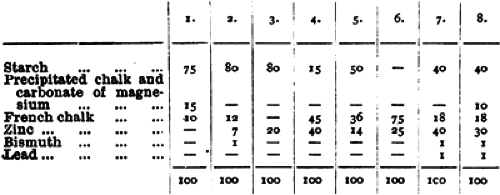
Above: Table showing the results of a chemical analysis of eight face powders examined by Murrell. (Murrell, 1897, p. 602)
Of the powders listed only specimens I, 3, 4, and 5 contained rice starch and number 6 which was labeled as ‘Poudre de Riz de Java’ contained no rice starch at all. Unfortunately, he did not identify the maker of each powder in his report. Another study by LaWall in 1915 showed similar substitutions. Only 4 of the 16 samples of rice powder were made up of at least 50% rice starch.
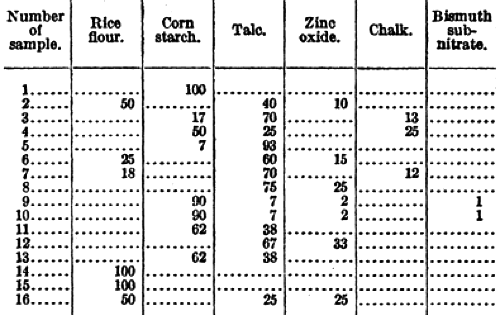
Above: Table showing the per cent composition of 16 powders labelled ‘poudre de riz’ examined by LaWall (Wilbert, 1915, p. 3066).
Unfortunately, a consumer is unlikely to be aware of a substitution and a bad experience with one powder labeled ‘poudre de riz ’ may put her off others similarly labelled.
Decline in the use of starch
As the twentieth century dawned and there was a greater acceptance of cosmetics, more face powders came on the market. The use of rice and other starches declined as a better understanding of inorganic ingredients enabled manufacturers to produce formulations in a consistent range of shades and weights. Talc had better slip than rice starch, zinc oxide better covering power, zinc stearate had better clinging power and calcium carbonate could add ‘bloom’. The requirements of new forms of make-up – compact, cake, cream, liquid and stick – accentuated this trend.
Rice starch also suffered from some negative press, including that it clumped when damp, clogged skin pores, encouraged bacterial growth and produced allergic reactions. These adverse characteristics were widely disseminated by suppliers of mineral alternatives and were written up in most cosmetic chemistry texts of the time. By the 1950s, using starch in powders had long since ceased to be the norm. However, not all cosmetic chemists were convinced by the adverse publicity.
At times, there has been so much publicity, always adverse and, in the writer’s opinion, unwarranted, regarding the use of rice starch in face powders, that most manufacturers have withdrawn it from their products. Since excellent powders can be made without rice starch, it seems unsound to continue to use it, if only from the standpoint of economic self-preservation, but this in no way alters the fact that a good powder can be made with this material.
(Martin, 1957, p.229)
As late as the 1980s, Harry’s Cosmeticology also suggested that the use of starch was down but not out. He denied that it clogged pores, suggested that bacterial decomposition of starch could be reduced by the addition of preserving perfume and pointed to new forms of treated starch that were reported to resist swelling and clumping (Harry, 1982, p. 290).
However, these voices were atypical and although there are still rice powders on the market, minerals and plastics seem set to dominate cosmetic powders for the foreseeable future.
Updated: 11th January 2015
Sources
Buc’hoz, P.-J. (1779). The toilet of flora. London: J. Murray.
deNavarre, M. G. (1941). The chemistry and manufacture of cosmetics. Boston: D. Van Nostrand Company.
Harry, R. G. (1982). Harry’s cosmeticology (7th ed.). London: Longmans.
Martin, J. R. L. (1957). Face powders. In E. Sagarin (Ed.), Cosmetics Science and technology (pp. 222-248). New York: Interscience.
Murrel, W. (1897). Report on an examination of “face powders.” The British Medical Journal. March 6, 602.
Phillips, M. C. (1934). Skin deep: The truth about beauty aids. New York: Garden City Publishing.
Poucher, W. A. (1932). Perfumes, cosmetics and soaps (4th ed., Vols. 1-2). London: Chapman and Hall Ltd.
Wilbert, M. I. (1915). Cosmetics as drugs: A review of some of the reported harmful effects of the ordinary constituents of widely used cosmetics. In Public Health Reports, 30(42) 3059-3066.
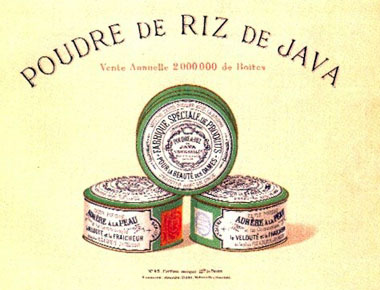
Bourjois Poudre de Riz de Java, first introduced in 1879.

La Diaphane Poudre de Riz.
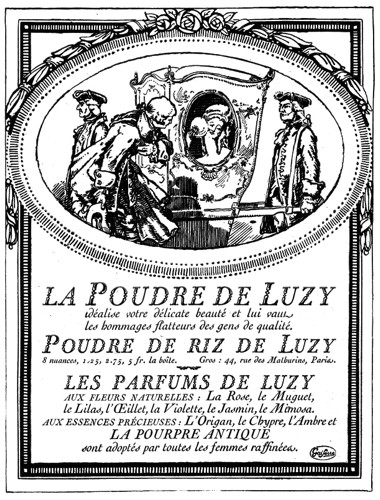
1919 Poudre de Riz de Luzy.
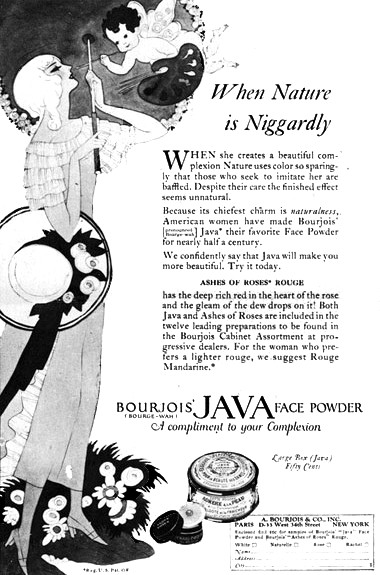
1922 Bourjois Java face powder. Any reference to ‘poudre de riz’ has disappeared.
